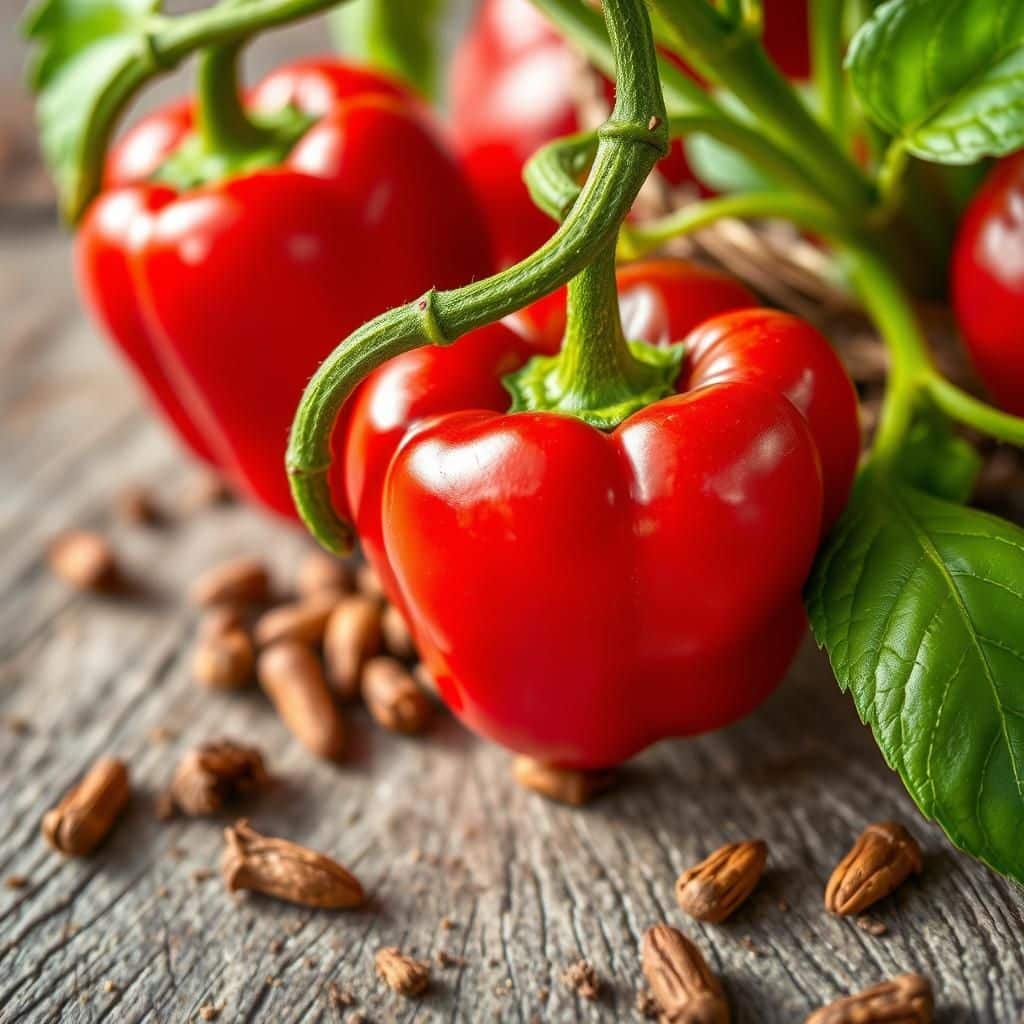Ultimate Guide: How to Grow Capsicum from Seeds for a Thriving Garden

Growing capsicum from seeds can be a rewarding endeavor for both novice and experienced gardeners alike. By nurturing these vibrant peppers from their earliest stages, you can enjoy a bountiful harvest of flavorful fruits that are perfect for a variety of dishes. This ultimate guide will provide you with step-by-step instructions, essential tips, and tricks to ensure your capsicum plants thrive in your garden. From selecting the right seeds to understanding optimal growing conditions, this comprehensive resource will empower you to cultivate healthy, productive capsicum plants and elevate your gardening experience. Dive in and transform your garden today!
How to Grow Capsicum from Seeds
Growing capsicum from seeds is a rewarding process that requires some planning and care. Begin by choosing high-quality seeds from a reputable source, ensuring they are suitable for your climate. Start the seeds indoors approximately 8 to 10 weeks before the last frost date to give them a head start. Use a seed-starting mix that retains moisture but provides good drainage. Plant the seeds about ¼ inch deep and keep the soil consistently moist but not waterlogged. Providing a warm environment with a temperature of around 70-85°F (21-29°C) will help the seeds germinate within 7 to 14 days. Once the seedlings have developed a few true leaves and the outdoor conditions are favorable, you can transplant them into the garden or larger pots, ensuring they have enough space to thrive.
Choosing the Right Seeds
When selecting capsicum seeds, it's important to consider the variety that best suits your gardening style and taste preferences. Capsicum comes in several types, such as bell peppers, hot peppers, and sweet peppers. Research the growing conditions required for your chosen variety, including the growing season, temperature tolerance, and pest resistance. Opt for organic seeds if you prefer chemical-free gardening, and look for certified disease-resistant varieties to enhance your seeds' chances of thriving.
Soil Preparation
Capsicum plants thrive in well-draining, nutrient-rich soil. Prepare the soil by testing its pH, ideally aiming for a range between 6.0 and 6.8. Before planting, enrich the soil with organic matter like compost or well-rotted manure, which provides essential nutrients and improves soil structure. Mixing in some sand can help improve drainage, especially if your soil tends to retain moisture. Creating raised beds can also benefit capsicum plants, as they tend to warm up faster in the spring.
Watering Techniques
Proper watering is crucial for healthy capsicum growth. The soil should remain consistently moist, especially during germination and early growth stages. However, it's important to avoid overwatering, which can lead to root rot or other diseases. Implement a watering schedule that allows the top inch of soil to dry out before adding more water. Using a layer of mulch can help retain moisture by reducing evaporation. Keep an eye on weather conditions, adjusting your watering frequency during hot or dry periods.
See also:
Transplanting Seedlings
Once your capsicum seedlings reach approximately 4-6 inches tall and have developed several sets of true leaves, they are ready for transplanting. Choose a location with full sun and adequate space for each plant, typically about 18-24 inches apart. Gradually acclimate the seedlings to outdoor conditions by hardening them off; this involves placing them outside for a few hours each day for about a week before full transplantation. When planting, dig a hole deep enough to cover the root ball, and water thoroughly to minimize transplant shock.
Pest and Disease Management
Capsicum plants can be susceptible to various pests and diseases, such as aphids, spider mites, and bacterial wilt. Regularly inspect your plants for any signs of infestation, and consider natural pest control methods such as introducing beneficial insects like ladybugs or using neem oil. Proper spacing and air circulation can help prevent fungal diseases. Practicing crop rotation is another excellent strategy to minimize risk, allowing you to reduce the chances of soil-borne diseases affecting your capsicum plants.
| Task | Best Practice |
|---|---|
| Choosing Seeds | Opt for disease-resistant and climate-suitable varieties. |
| Soil Preparation | Use a well-draining, nutrient-rich mix and test pH levels. |
| Watering | Maintain consistent moisture without overwatering. |
| Transplanting | Acclimate seedlings and provide adequate spacing. |
| Pest Management | Monitor regularly and employ natural pest control methods. |
Optimal Conditions for Germinating Capsicum Seeds
Growing capsicum from seeds requires understanding the optimal conditions for germination. Capsicum seeds thrive in a warm, consistent environment, ideally with a soil temperature between 70°F to 85°F (21°C to 29°C). To achieve this, consider using a seedling heat mat to maintain warmth. Additionally, using a moisture-retentive soil mix can greatly enhance germination rates, as seeds need a humid environment but should not be waterlogged. Ensure that they receive adequate light, as seedlings will require around 12-16 hours of bright light each day once they begin to sprout.
Choosing the Right Capsicum Varieties
Selecting the right varieties of capsicum is crucial for a thriving garden. There are many types, including bell peppers, chili peppers, and sweet peppers, each with unique growth habits and flavor profiles. It's essential to consider your climate and intended use when choosing a variety. For instance, if you live in a warmer climate, heat-tolerant varieties may perform better. Researching and selecting varieties that suit your gardening style and preferences will set the stage for a successful growing season.
Preparing Seeds for Planting
Before planting, it's vital to prepare the seeds properly to improve germination. Soaking the seeds in warm water for 24 hours can enhance moisture absorption. Additionally, scarifying the seeds lightly with sandpaper can help break down the seed coat, facilitating quicker germination. Once they are adequately prepared, sowing them in seed trays filled with a quality seed-starting mix ensures they have the best possible start for robust growth.
See also:
Seedling Care and Maintenance
Once your capsicum seeds have germinated, proper care and maintenance of seedlings are essential for their development. Ensure the seedlings receive adequate light, either from natural sunlight or grow lights, which will prevent them from becoming leggy. Regularly monitor the soil moisture, keeping it consistently moist but not soggy, and considering gentle fertilization with a diluted, balanced fertilizer once the first true leaves appear. Proper airflow around the seedlings can also help prevent diseases.
Transplanting Capsicum Seedlings
Transplanting your capsicum seedlings is a critical step in their growth process. Wait until the seedlings have developed at least two sets of true leaves before moving them outdoors. Choose a cloudy day or late afternoon for transplanting to reduce transplant shock. Prepare the garden bed by ensuring it is well-drained and enriched with compost. When planting, set the seedlings deep enough to cover the stem up to the first set of leaves, promoting a stronger root system.
Pest and Disease Management for Capsicum Plants
Managing pests and diseases effectively will ensure a healthy capsicum yield. Regular checks for common pests like aphids, whiteflies, and spider mites can help control infestations early. Using companion planting with marigolds or employing organic pesticides can safeguard your plants. Additionally, monitoring for diseases like powdery mildew or blight is critical; ensuring good air circulation and proper plant spacing can help prevent these issues. Keeping the garden clean and removing debris will further reduce potential disease threats.
Questions from Our Readers
How long does it take for capsicum seeds to germinate?
Capsicum seeds typically take about 7 to 14 days to germinate, depending on the temperature and moisture levels. Keeping the soil between 70°F and 85°F (21°C to 29°C) will help ensure quicker germination.
What is the best soil for growing capsicum from seeds?
The best soil for growing capsicum from seeds is a well-draining potting mix that retains moisture but does not become waterlogged. A mix rich in organic matter and with a pH level between 6.0 and 7.0 is ideal for healthy growth.
See also:
When should I plant capsicum seeds outdoors?
It is best to plant capsicum seeds outdoors after the last frost date in your area when the soil has warmed to at least 60°F (16°C). This will help ensure that the seeds have the best environment for successful growth and fruit production.
How often should I water capsicum plants?
Capsicum plants require consistent moisture, so you should water them regularly, about 1 to 2 inches per week depending on weather conditions. It is important not to overwater; instead, let the top inch of soil dry out before watering again to promote healthy root development.

If you want to read more articles like Ultimate Guide: How to Grow Capsicum from Seeds for a Thriving Garden, we recommend you check out our Seeds category.
Leave a Reply
Related Articles